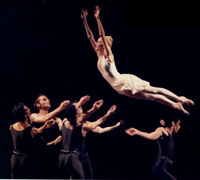
Choreography: Todd Bolender
Music: David Baker, George Gershwin
Set Design: Dale Eldred
Costume Design: Bud Santora
A commission to create a ballet in honor of the Sesquicentennial of the University of Missouri is not an assignment lightly taken. For choreographer Todd Bolender the challenges were several. He wanted to create an enduring work of generous dimension, to utilize the strengths of his talented young company, and to reflect both the significance of the occasion and the spirit of the institution honored. Considering, and eventually discarding, the possibilities of a story/history ballet based on events and personalities identified with the University and the region, he came at last to the idea upon which this work is centered. That idea became Celebration. The work premiered in these performances is above all celebratory, a theatrical fusion of music, movement and color in a piece which mirrors the vigor that created and sustained the University. The dances and dancers here assembled mark the 150th year with wit, bravura and unflagging energies, qualities that were surely necessary to the founders and shapers of a great enduring university. The catalogue of dance forms reaches back to the time of the institution’s founding with the waltz and the cakewalk, and stretches into this century with bows to the sleek performances of movie memory.
Celebration begins with vaudeville, a natural and affectionate nod to Bolender’s cherished memories of theatrical Saturdays in the company of his father for performances at the Loew’s and the Palace in Canton, Ohio. That fondness comes alive again in this piece. The opening score, and four additional numbers in the ballet are by American composer David Baker, was originally commissioned for a work planned in 1974 by Bolender for the Harkness Ballet.
Although full of promise, that work was never completed and Baker’s music and Bolender’s choreographic outlines were set aside, awaiting the right time, the perfect occasion. The sesquicentennial seemed just that perfect occasion, a worthy opportunity to present Baker’s sprightly score, to bring Bolender’s theatrical vision to reality.
With the incorporation of eight familiar, danceable (and singable) Gershwin tunes, the unifying and striking impact of Dale Eldred’s set design, and costumes designed by Bud Santora with confident authenticity and a dazzle of color and light, vaudeville comes alive.
The dances are in the vernacular tradition, and although raised here to intimidating virtuosity, they remain familiar, cheerful, and optimistic. The audience knows by participation the waltz, the Charleston, and by observation, the soft shoe, and the cakewalk. They are like old and loved friends; they need no introduction.
Celebration abounds with allusions, not only to vaudeville, but to burlesque, to musical theatre, and to films.
In Santora’s costumes are reflections of Ziegfield and Erté, of the circus high-wire, of the flapper frenzy. He offers broad hints of Chaplin, of Carole Lombard and George Raft, of Fred and Ginger, imitations of a world of others.
The costumes serve to heighten, to intensify the choreography, with a variety which runs from techincolor fantasy to punctuating splashes of black and white. Whatever the colors they are essential to the work’s totality.
The State Ballet’s celebratory salute to the University of Missouri is to be performed in coming months in Columbia and St. Louis.
